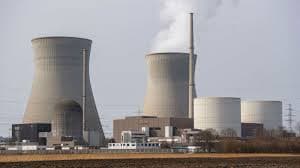Loading News Article...
We're loading the full news article for you. This includes the article content, images, author information, and related articles.
We're loading the full news article for you. This includes the article content, images, author information, and related articles.
Siaya County Governor James Orengo highlights the potential for significant employment opportunities and reduced electricity costs with the proposed nuclear power plant in the region, aligning with national industrialisation goals.

Siaya County Governor James Orengo has publicly advocated for the establishment of a nuclear power plant in the devolved unit, asserting that it will be a catalyst for job creation and provide cheaper electricity to foster industrialisation. Speaking on Wednesday, October 8, 2025, Governor Orengo indicated that the county government plans to collaborate with local higher learning institutions, such as Jaramogi Oginga Odinga University of Science and Technology (JOOUST), to equip residents with the necessary skills for the nuclear energy sector.
The proposed nuclear power plant in Siaya marks a significant shift in Kenya's energy strategy, following earlier community opposition that stalled plans in Kilifi County. Lwanda Kotieno in Rarieda sub-county has been identified as a leading candidate site, a decision that emerged from a high-level stakeholder forum in Bondo, Siaya County, where local leaders endorsed the project.
Kenya's journey towards nuclear energy began in 2010 with the aim of diversifying its energy sources and supporting the Vision 2030 development agenda. The Nuclear Power and Energy Agency (NuPEA), formerly the Kenya Nuclear Electricity Board (KNEB), is the state agency spearheading the country's nuclear power programme.
The country is currently in Phase 2 of the International Atomic Energy Agency (IAEA) milestones approach for new nuclear power programmes, having made progress in feasibility studies, legal frameworks, and human capital development. Kenya enacted a national nuclear law in 2019 and established a regulatory body with responsibilities for safety, security, and safeguards.
The Least Cost Power Development Plan (LCPDP) and the Energy Bill 2016 recognise the inclusion of nuclear energy in Kenya's energy mix. NuPEA's strategic plan for 2023-2027 outlines a comprehensive strategy for establishing the necessary infrastructure for nuclear facilities, with a strong emphasis on safety and security. The government aims to achieve 100% clean energy by 2030 and Net Zero by 2050, with an estimated USD 600 billion of investments required for the energy transition.
Governor Orengo's statements underscore the county's commitment to the project, envisioning a faculty at JOOUST to train individuals with the necessary skills for the plant. This initiative aligns with NuPEA's efforts to collaborate with local universities to train nuclear scientists and increase the number of experts in the field. Already, 66 nuclear scientists have been trained in collaboration with the University of Nairobi, with negotiations underway with Jomo Kenyatta University of Agriculture and Technology and five Technical and Vocational Education and Training Authority (TVETA) institutions.
While Siaya leaders have shown receptiveness, concerns persist regarding safety, radioactive waste disposal, and long-term financial sustainability. Environmental groups like Greenpeace Africa have warned against potential damage to coastal environments and highlighted the lack of clear policies for managing nuclear waste, advocating instead for full investment in renewable energy sources.
The substantial investment required for a nuclear power plant, estimated at KSh 500-600 billion, raises concerns about potential cost and time overruns, as experienced in other mega-projects in Kenya. There are also inherent risks associated with nuclear technology, including safety concerns, the disposal of radioactive waste, and the long-term financial commitment for maintenance.
While nuclear power offers a stable and reliable source of electricity, the complexity of design and operation necessitates a highly skilled workforce and robust regulatory oversight. The reliance on foreign technology and expertise for critical aspects of the energy infrastructure, such as Small Modular Reactors (SMRs) needing to be returned to manufacturing facilities for refueling, could lead to dependency on vendor countries.
Despite the government's ambitious timeline, the realism of commencing construction by 2027 and commissioning by 2034 remains questionable, given that detailed plans are yet to be completed and a contractor for the project has not been selected. The exact site within Siaya County is still under study, with several potential points around Lake Victoria being considered.
Public education and engagement are crucial to address fears surrounding radiation and accidents, which were significant factors in the opposition faced in Kilifi. The long-term management of nuclear waste also remains a key concern, with NuPEA stating that waste would be stored for 100 years before being collected and placed in underground depositories by international suppliers.
The government plans to hold extensive consultations with stakeholders in Siaya County, including Governor Orengo, Senator Oburu Oginga, Members of Parliament, Members of County Assembly, and the local community. These discussions were scheduled for Thursday, June 26, 2025.
The coming months will be critical for the Siaya nuclear power plant project, with key developments to watch including: